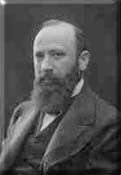David Wolffsohn
(1856 - 1914)
Born in Lithuania, Wolffsohn received a religious education and in 1873 was sent to live with his brother in order to avoid conscription into the czarist army. He studied at a talmud torah run by one of the leaders of the future Hibbat Zion movement. As a young adult, he held a number of jobs before going into the timber business, eventually becoming quite wealthy.
Wolffsohn's Zionist leanings increased with the appearance of Herzl's book, The Jewish State. He met Herzl in 1896, promised his help and became Herzl's constant companion. Their relationship was so strong that he became guardian of Herzl's children.
Following Herzl's death, there was a vacuum in the movement's leadership. Different candidates were suggested to succeed Herzl, but in the end, three were agreed on at the Seventh Zionist Congress: Wolffsohn, Max Nordau and Otto Warburg. After the Eighth Congress, when Wolffsohn was elected president of the Zionist Organization, an official visit to Turkey was cut short by the revolution there. The same year he visited Russia, where he was received by both the Prime Minister and the Foreign Minster and then visited Hungary. His presence in Russia and Hungary bolstered the Zionist cause in both countries. Wolffsohn was re-elected president at the Ninth Zionist Congress in 1909, but by the Tenth Congress, his health was failing and the opposition, the "practical" Zionists, was gaining strength. He resigned from the presidency, remained active in the financial and economic side of the organization, and intended to move to Eretz Yisrael, but never fulfilled this wish. He died in 1914 and was buried in Cologne. In 1952 his remains were moved to Jerusalem where they were re-interred next to Herzl's.
Beginning as Herzl's friend, David Wolffsohn met the challenge of leadership of the Zionist movement, and despite his early reluctance, made a number of fundamental decisions. While Herzl was still alive, it was Wolffsohn, with his religious background, who suggested that the movement's flag be blue on white like a tallit. He also suggested that members pledge a shekel to the movement.
The Uganda Plan was defeated at the Seventh Zionist Congress and the Basle Program which endorsed increased settlement activity was adopted. At this point Wolffsohn was already involved in attempting to bridge the gap between the "political" and the "practical" Zionists.
After the Seventh Zionist Congress, Wolffsohn was instrumental in moving all the Zionist offices to Cologne. This encouraged the Jewish National Fund to move there as well. He asked Nahum Sokolow to be the organization's general secretary and in 1907 he founded HaOlam, the organization's official newspaper. Although debate at the Eighth Zionist Congress was particularly heated, Wolffsohn proved himself to be an accomplished mediator by insisting that all of the organization's practical programs (including JNF activities and new settlements) were in keeping with Herzl's plan.
Already in failing health, he went on vacation to South Africa in 1906, a Zionist milestone, because he set in motion the founding of the South African Zionist Federation. After his return, he overcame serious opposition and agreed to grant a JNF loan to the first settlers in Ahuzat Bayit which would later become the center of Tel Aviv.
Wolffsohn's personality and work were only really appreciated posthumously. Even his opponents later admitted that he was a man of the people who had come up through the ranks as a result of decades of hard work. Recognized as a symbol of the synthesis of Eastern and Western Europe, he was thought to combine the best qualities of both Jewish communities. After his death, Wolffsohn's estate provided the means to build the National and University Library building at the Hebrew University in Jerusalem.
Courtesy of:

